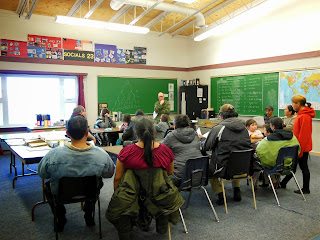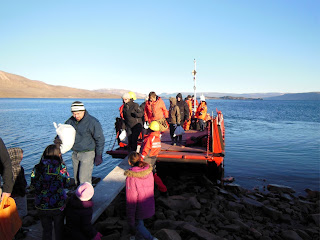The
month of September began with the appearance of snow. The town was coated in a thin layer of white
on Sunday, September 1st, a sight I wasn't expecting to see. Prior to this, the Arctic snow only blanketed
the surrounding mountains. While walking
to and from school after a long day of planning lessons & correcting work,
I snapped several photos of the snow covered town. The snow had melted by the next day. Mother Nature was most likely giving the
residents of Arctic Bay a sample of what was to come in the following months.
The
first school day of September was a day of strong cold winds. I don't remember the velocity but they were
fierce enough to warrant the wearing of many layers of winter clothing. Out in the bay, a Canadian Coast Guard Ship
that looked similar to the CCGS Des Groseilliers rocked in the frigid Arctic
water.
On
Saturday, September 7, residents of Arctic Bay participated in a Walk/Run for
Diabetes, organized by the Northern Store and the Canadian Diabetes Association
(CDA). Diabetes is a chronic and
sometimes fatal disease where the body doesn't produce enough insulin or
improperly uses the insulin it produces.
This can lead to high levels of glucose in the blood, damaging organs,
nerves, and blood vessels. There are 4
types of diabetes: Type 1, Type 2, Gestational, and Prediabetes. Currently there are 9 million Canadians
living with diabetes. The event was
organized to raise money to find a cure for the disease and to promote a healthy
lifestyle. Participants could either run
or walk a 2.5 or 5-kilometre distance.
Unfortunately, I didn't have time to participate. The event drew around 30 participants, some
of who were Inuujaq School students, and a generous amount of money was raised.
 |
| CCGS Louis S. St. Laurent |
The
town welcomed yet another Canadian Coast Guard Ship on September 8. The CCGS Louis St. Laurent is one of two
heavy icebreakers in the coast guard fleet and is Canada's largest
multi-mission icebreaker. The
119.6-metre vessel, based in St. John's Newfoundland, was built in 1969, and is
operated by a crew of 42. The St.
Laurent travels to the Arctic during the summer months to assist in the annual
sealift and also participates in scientific expeditions. It was one of the first surface vessels to
reach the North Pole on August 22, 1994.
Unfortunately, no tours were offered and the ship left the next day. The St. Laurent was originally scheduled to
be decommissioned in 2000 but a refit extended the ship's life to 2017. At that time, a newly constructed replacement
vessel, the John G. Diefenbaker, will come into service.
 |
| Lt. Frank May, CO of 3045, explains the cadet program to parents. |
On
the evening of September 11th, 3045 Army Cadet Corps was hosting a recruitment
night at Inuujaq School. The regular
training year had just started and the corps administration was already
enticing parents to enroll their children in an exciting Canada-wide youth program. Since the commanding officer
(CO) was expecting a large group of parents, the meeting was held in my
classroom. After the CO's detailed
speech about the cadet program and how everything works, interested parents
were asked to fill out the necessary forms.
At the end of the night, I believe five new recruits were signed up.
On
a somber note, it is hard to believe that 12 years have passed since the
September 11th terrorist attacks on New York City & Washington D.C. So much has happened since then and yet, I
can still remember where I was on that day.
Several of my students were also able to recall where they were. The mastermind behind the deadly attacks has
been dead for two years but I'm not sure if the world is any safer.
On
September 12th, the large oil tanker Havelstern dropped anchor in Arctic Bay to
refill the five oil tanks at the town's 'Gas Station'. The vessel is operated by Coastal Shipping Limited, a division of Woodward Group of Companies. A long & robust tube was used to transfer
the oil and gas to the large tanks.
There is enough oil and gas in the tanks to satisfy demand for a year.
My
Grade 10 Social Studies students continued working through the Canadian
Identity unit, learning new terms such as multiculturalism, bilingualism,
regionalism and alienation. We also
touched on Canadian/American relations and how Americans view Canadians. Despite the advances in media &
technology, I still find that the further south you travel in the United
States, the less people know about Canada.
My
Grade 11 Social Studies students finished the section on the French Revolution
and its lasting impact on the world.
They all did fairly well on the review test. We started the last section of the
Nationalism unit: Nationalism & Conflict.
This section examines German nationalism in the late 1800s, the causes
of the First World War, and the war itself.
My students would learn the basics of imperialism, propaganda, economic
rivalries, and the nature of trench warfare.
To bring the course material 'closer to home', I also prepared topics
that dealt with Canada's involvement in the First World War, at home and on the
battlefields (ie. Ypres, Somme).
 |
| September 1, 2013 |
In
Grade 12 Social Studies, my students studied the topic of individualism, what
it means, and how it affects people and society. There are advantages and disadvantages to
individualism, too many for me to list in this post. To get a better understanding of the word,
they also briefly learned about collectivism, the opposite of
individualism. I didn't give away too
much because collectivism is the topic of the next section.
My
drummers are getting more and more coordinated and disciplined with every
passing day. Their volume control on the
actual drums is getting better but the loud rhythmic sounds still attract curious
onlookers from the hallway. For new
material, we looked at a list of intermediate level drum rudiments, a warm up I
wrote when I was teaching in Iqaluit, and a collection of stick visuals and
tricks. Of course, we reviewed the exercises
and rudiments they previously learned.
Repetition, no matter how boring it may become, is essential in
maintaining a disciplined and well rehearsed drum line. I also began researching pieces that would be
well suited for my drummers to perform in front of an audience. I would like my drummers to publicly perform at least
twice this semester; on Halloween and at the Christmas concert.
 |
| King George V Mountain. September 9, 2013. |





























































